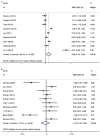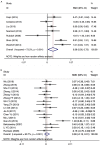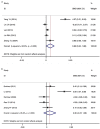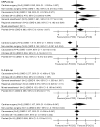Inflammatory markers in postoperative delirium (POD) and cognitive dysfunction (POCD): A meta-analysis of observational studies
- PMID: 29641605
- PMCID: PMC5895053
- DOI: 10.1371/journal.pone.0195659
Inflammatory markers in postoperative delirium (POD) and cognitive dysfunction (POCD): A meta-analysis of observational studies
Erratum in
-
Correction: Inflammatory markers in postoperative delirium (POD) and cognitive dysfunction (POCD): A meta-analysis of observational studies.PLoS One. 2018 Dec 13;13(12):e0209284. doi: 10.1371/journal.pone.0209284. eCollection 2018. PLoS One. 2018. PMID: 30543703 Free PMC article.
Abstract
Background: The aim of this study was to summarize and discuss the similarities and differences in inflammatory biomarkers in postoperative delirium (POD) and cognitive dysfunction (POCD).
Methods: A systematic retrieval of literature up to June 2017 in PubMed, Embase, the Cochrane Library, the China National Knowledge Infrastructure database, and the Wanfang database was conducted. Extracted data were analyzed with STATA (version 14). The standardized mean difference (SMD) and the 95% confidence interval (95% CI) of each indicator were calculated using a random effect model. We also performed tests of heterogeneity, sensitivity analysis, assessments of bias, and meta-regression in this meta-analysis.
Results: A total of 54 observational studies were included. By meta-analysis we found significantly increased C-reactive protein (CRP) (9 studies, SMD 0.883, 95% CI 0.130 to 1.637, P = 0.022 in POD; 10 studies, SMD -0.133, 95% CI -0.512 to 0.246, P = 0.429 in POCD) and interleukin (IL)-6 (7 studies, SMD 0.386, 95% CI 0.054 to 0.717, P = 0.022 in POD; 16 studies, SMD 0.089, 95% CI -0.133 to 0.311, P = 0.433 in POCD) concentrations in both POD and POCD patients. We also found that the SMDs of CRP and IL-6 from POCD patients were positively correlated with surgery type in the meta-regression (CRP: Coefficient = 1.555365, P = 0.001, 10 studies; IL-6: Coefficient = -0.6455521, P = 0.086, 16 studies).
Conclusion: Available evidence from medium-to-high quality observational studies suggests that POD and POCD are indeed correlated with the concentration of peripheral inflammatory markers. Some of these markers, such as CRP and IL-6, play roles in both POD and POCD, while others are specific to either one of them.
Conflict of interest statement
Figures







References
-
- Arthur GL, Brende JO, Locicero KA. Diagnostic and statistical manual of mental disorders (4th ed) and text revision. Psychology Psychiatry Autism Family Therapy. 2001.
-
- Maclullich AMJ, Ferguson KJ, Miller T, Rooij SEJAD, Cunningham C. Unravelling the pathophysiology of delirium: A focus on the role of aberrant stress responses. Journal of Psychosomatic Research. 2008;65(3):229 doi: 10.1016/j.jpsychores.2008.05.019 - DOI - PMC - PubMed
-
- Young J, Inouye SK. Delirium in older people. Bmj. 2007;334(7598):842–6. doi: 10.1136/bmj.39169.706574.AD - DOI - PMC - PubMed
-
- Inouye SK. Delirium in older persons. N Engl J Med. 2006;354(11):1157–65. doi: 10.1056/NEJMra052321 - DOI - PubMed
-
- Marcantonio ER. Postoperative Delirium: A 76-Year-Old Woman With Delirium Following Surgery. Jama the Journal of the American Medical Association. 2012;308(1):73 doi: 10.1001/jama.2012.6857 - DOI - PMC - PubMed
Publication types
MeSH terms
Substances
LinkOut - more resources
Full Text Sources
Other Literature Sources
Medical
Research Materials
Miscellaneous

